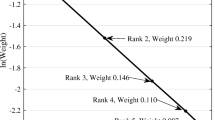Abstract
We investigated the distribution functions of Korea’s top-rated companies during two financial crises. A power-law scaling for rank distribution, as well as cumulative probability distribution, was found and observed as a general pattern. Similar distributions can be shown in other studies of wealth and income distributions. In our study, the Pareto exponents designating the distribution differed before and after the crisis. The companies covered in this research are divided into two subgroups during a period when the subprime mortgage crisis occurred. Various industrial sectors of Korea’s companies were found to respond differently during the two financial crises, especially the construction sector, financial sectors, and insurance groups.
Similar content being viewed by others
References
E. Borensztein and J. W. Lee, J. Monetary Econ. 49, 853 (2002).
J. Koo and S.L. Kiser, Economic Financial Policy Rev. Q IV, 24 (2001).
G. Ferri and T. S. Kang, Economic Notes 28, 195 (1999).
M. Goldstein, The Asian Financial Crisis: Causes, Cures, and Systemic Implications (Institute for International Economics, Washington D.C., 1998), Chap. 2.
T. Preis, J. J. Schneider and H. E. Stanley, Proceed. National Acad. Sci. 108, 7674 (2011).
R. N. Mantegna and H. E. Stanley, An Introduction to Econophysics (Cambridge University Press, New York, 1999).
B. Podobnik, A. Valentinčič, D. Horvatić and H. E. Stanley, Proceed. National Acad. Sci. 108, 17883 (2011).
W. B. Arthur, Complexity 1, 20 (1995).
B. LeBaron, W. B. Arthur and R. Palmer, J. Econ. Dynam. Con. 23, 1487 (1999).
B. Solnik, C. Bourcrelle, and Y. Le Fur, Finan. Anal. J. 52, 17 (1996).
R. N. Mantegna and H. E. Stanley, Nature 376, 46 (1995).
T. Lux and M. Marchesi, Nature 397, 498 (1999).
M. H. R. Stanley, L. A. N. Amaral, S. V. Buldyrev, S. Havlin, H. Leschhorn, P. Maass, M. A. Salinger and H. E. Stanley, Nature 379, 804 (1996).
B. Podobnik, D. Wang, D. Horvatic, I. Grosse and H. E. Stanley, Europhys. Lett. 90, 68001 (2010).
V. Pareto, Cours d’Economique Politique (Macmilan, London, 1897), vol. 2.
R. Gibrat, Les Inégalités Économiques (Sirey, Paris, 1931).
S. Sinha, Physica A 359, 555 (2006).
M. Levy and S. Solomon, Physica A 242, 90 (1997).
O. S. Klass, O. Biham, M. Levy, O. Malcai and S. Solomon, Econ. Lett. 90, 290 (2006).
A. Dragulescu and V. M. Yakovenko, Physica A 299, 213 (2001).
M. Levy and S. Solomon, Intern. J. Mod. Phys. C 7, 65 (1996).
W. Souma, Fractals 9, 463 (2001).
E. Byron, As Middle Class Shrinks, P&G Aims High and Low, The Wall Street Journal Business (Sep. 12, 2011).
S. Redner, European Phys. J. B 4, 131 (1998).
D. Wang, B. Podobnik, D. Horvatić and H. E. Stanley, Phys. Rev. E 83, 046121 (2011).
R. Novy-Marx, J. Finan. Econ. 108, 1 (2013).
Real Potential Gross Domestic Product, Congressional Budget Office, United States Congress, http://research.stlouisfed.org/fred2/data/GDPPOT.txt.
Econstats, World Economic Outlook (WEO) data, IMF, http://www.econstats.com/weo/V009.htm.
Private final consumption expenditure (real percentage change), Economic Statistics System, The Bank of Korea.
O. S. Klass, O. Biham, M. Levy, O. Malcai and S. Solomon, European Phys. J. B 55, 143 (2007).
Author information
Authors and Affiliations
Corresponding author
Rights and permissions
About this article
Cite this article
Lim, K., Kim, S.Y., Swanson, T. et al. Effects of the financial crisis on the wealth distribution of Korea’s companies. Journal of the Korean Physical Society 70, 236–244 (2017). https://doi.org/10.3938/jkps.70.236
Received:
Accepted:
Published:
Issue Date:
DOI: https://doi.org/10.3938/jkps.70.236




